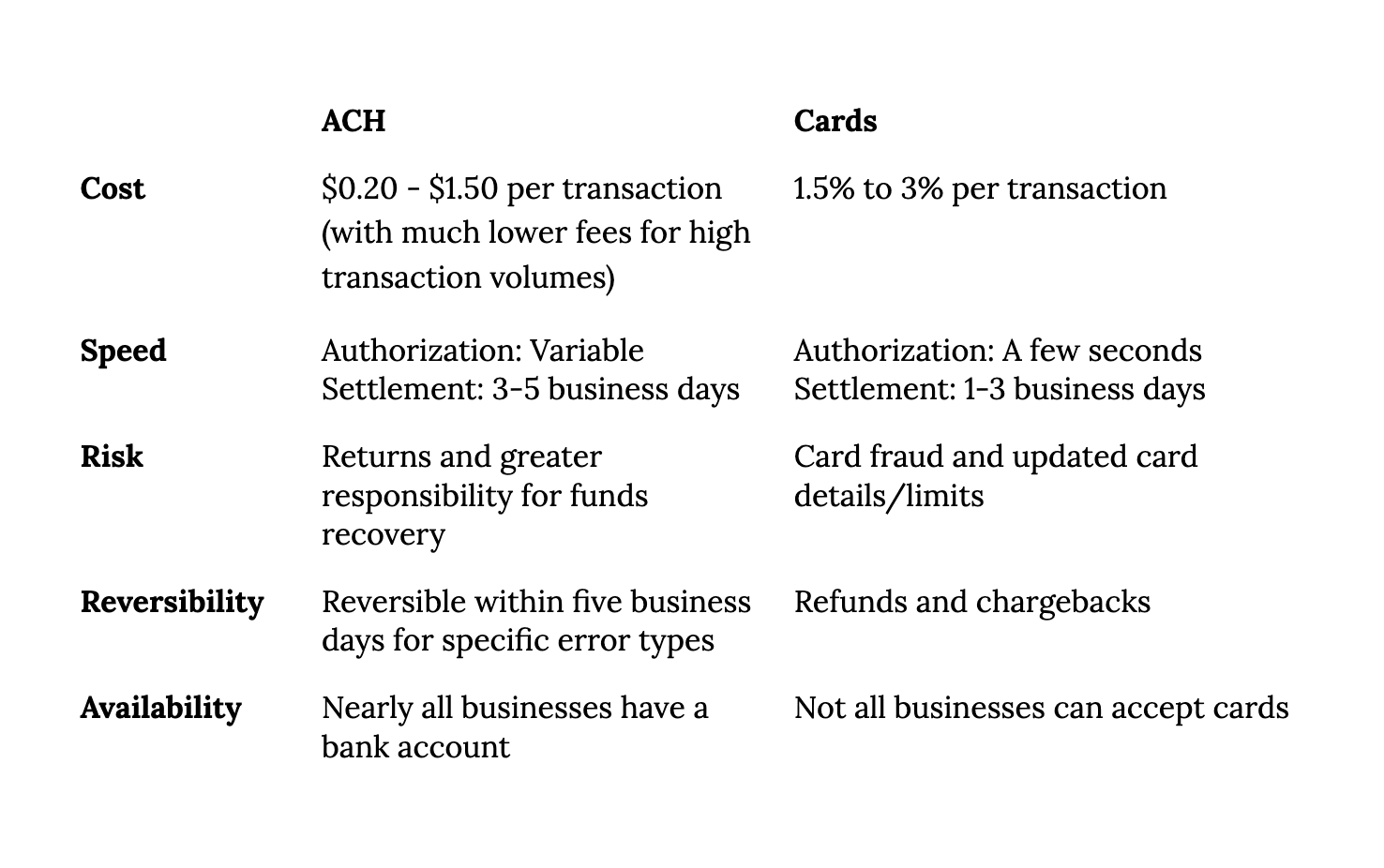Modern Treasury and Paxos Make It Easier for Businesses to Move Money with Stablecoins.Learn more →
Key Differences Between ACH and Cards
Understanding the differences between ACH and card payments is a strategic necessity for businesses looking to scale. This journal digs into key distinctions and selection criteria for making the best choice.

When it comes to moving funds, modern companies can leverage an incredible range of options. Still, two long-standing payment systems—ACH and cards—continue to dominate the financial landscape. What are the major differences between them and what criteria should you use to select the right option?
Understanding ACH
ACH accounts for the lion’s share of annual domestic payments—an estimated 82% [1]. Many organizations have adopted ACH for processes like automatic, recurring bill pay, due to the convenience of ACH relative to check or cash payments.
ACH bottom line: Standard ACH can take 3-5 days and cost between $0.20 and $1.50 per payment, regardless of whether you are making or receiving payments. Note: ACH pricing can be significantly lower for companies who move very large transaction volumes. Same Day ACH can be processed in one business day and the fee generally ranges between $0.25 and $.075 per payment.
Source of funds: ACH funds are tied to a bank account and limited by the account balance.
Top benefits of ACH: Relatively low fixed cost and convenience for recurring transactions.
For deeper insight into ACH, download this free eBook.
Understanding Cards
The model for most cards used today was introduced in 1958 when Bank of America mailed BankAmericards to 60K unsuspecting Fresno residents. Since that first drop, “open-loop” cards (cards that can be used to pay any merchant in the card network) have continued to evolve, facilitated in the US by two primary card networks that partner with banks—Visa and Mastercard. These networks connect four parties that participate in every Visa and Mastercard payment [2]:
- Merchant: The personal or organization selling goods or services that accepts card payments.
- Cardholder: The customer seeking to make a purchase from the merchant with a card.
- Issuing Bank: The bank responsible for issuing the card to the customer.
- Acquiring Bank: The merchant’s bank partner that processes payments on the merchant's behalf.
In addition to connecting these parties to facilitate payments, card networks also serve as a clearing house, manage card rules and regulations, and set transaction fee rates. Note: Amex and Discover are distinct from Visa and Mastercard in that they issue their own cards, without bank partnership.
Unless a merchant has built an in-house system for connecting with the Acquiring Bank, they will need a third-party Acquiring Processor like Stripe, Square, Adyen, Fiserv, or Worldpay. The Issuing bank also needs an Issuer Processor like TSYS, Global Payments, FIS, or Fiserv to connect with payment networks.
Bottom line on cards: Card transactions can be authorized in seconds but generally take between one and three business days to settle. Each card and payment type (online or in-person) commands different merchant fees—most recently $.23 per payment for debit cards to anywhere between 1.5%–3% for credit cards. In 2021, merchants in the US paid $77.48 billion in credit card fees and $28.06 billion in debit card fees imposed by Visa and Mastercard.
Card fees include:
- Interchange fees, which go to all parties but primarily the issuers, who handle the marketing and servicing of cards, as well as the customer relationship.
- Assessment fees, paid by the merchant to be part of the card network
- Payment processor fees, for a payment service provider (PSP) like Stripe
Source of funds: When you use a credit card, you are borrowing funds from the Issuing Bank, up to the account limit. When you use a debit card, you are drawing from bank account funds and limited by the account balance.
Top benefits of cards: Utility (customer convenience), liquidity (borrowing power), and rewards (loyalty and cash-back).
Differences Between ACH and Cards: 5 Key Considerations
When it comes to making and receiving payments, most organizations use some combination of banking and credit rails to move money. Each method offers distinct benefits and drawbacks. Let’s dig into the major differences between standard ACH and card payments, based on four criteria: cost, speed, risk, reversibility, and availability. To compare Same-Day ACH to other payment methods, check out this article.

1. Cost
Cost is probably the most significant differentiator between ACH and cards, especially for businesses moving high dollar volumes and/or significant scale—ACH involves flat fees whereas card fees are percentage-based. A few dollars in daily fees can be well worth the convenience of offering cards for smaller merchants but prohibitive for larger enterprises.
ACH is relatively inexpensive, costing between $0.20 and $1.50 per payment, regardless of the amount (up to daily limits set by the banks involved).
Cards have steeper fees—most credit cards cost between 1.5% to 3% per transaction (a combination of interchange, assessment, and processing fees)
2. Speed
Depending on the circumstance, the speed at which authorization and settlement occur can have huge impacts for a business. In a storefront purchase, for example, waiting on ACH would be a deal killer; for mortgage payments, on the other hand, a slightly longer timeframe for ACH has fewer ramifications and significantly lower fees.
ACH authorization requires the verification of bank accounts, through the sharing of account details and either prenotes, microdeposits, or an integration with a service like Plaid. The timing here is variable—the first authorization can take a few days, whereas subsequent authorizations will happen automatically.
ACH settlement can take between three to five business days, although some funds may settle within two days.
Card authorization speed is one of the major advantages of the technology, happening within seconds. Because of modern card network technology and the procedures for establishing an account (see “Risk” below), authorization is incredibly fast.
Card settlement generally takes between one to three business days.
3. Risk
Risk management is a fundamental payments challenge—every transfer of money involves some level of risk, with different considerations for ACH vs. cards.
With ACH, once an account and routing number have been verified, the primary risk is a return. The RDFI (or receiving depository financial institution) must initiate a return request within a specific time frame based on the type of return. The ACH return process can take time—between two and 60 days.
One common ACH return is NSF (for insufficient funds), when a debited account doesn’t hold enough money to cover a charge—the digital equivalent of a bounced check. NSF is tricky with ACH because it can potentially take several days for the party collecting a payment to know the funds aren’t available. Luckily, services like Plaid do offer NSF protection. And on the upside, once a bank account is established, the account and routing numbers will never change (unlike cards).
Cards tend to be easier and more common vehicles for fraud than ACH. Not only are cards more widely accepted for purchases—physical cards (and card numbers) can be stolen and used immediately, since the bulk of compliance and fraud protection happen when a card account is opened (rather than after).
For recurring card transactions, there is the danger of expired cards and updated card numbers, as well as maxed out cards, leading to declined transactions. In each of these cases, however, merchants receive ostensibly greater support in recovering funds from the card networks than businesses do from the ACH network or individual banks.
4. Reversibility
Both ACH and cards are reversible, with different protocol and terminology governing each process.
An ACH reversal, in which a payment originator seeks to take back an erroneous ACH payment, is possible within five business days of fund settlement. Unlike an ACH return, wherein the RDFI (or receiving depository financial institution) is responsible for the process, NACHA, the National Automated Clearing House Association, facilitates reversals.
NACHA has designated five conditions under which an ACH reversal is allowable:
- Duplicate payment
- Incorrect payment recipient
- Incorrect payment amount
- Payment date earlier than intended (ACH debit only)
- Payment date later than intended (ACH credit only)
For cards, when a customer successfully disputes a charge, there are two possible outcomes. In the case of a refund, a customer contacts the merchant directly and the merchant returns the funds in question to the customer. For a chargeback, a customer disputes the charge through the issuing bank and the issuing bank credits the customer’s card account until a final decision is reached.
There are three types of chargebacks [3]:
- Fraud: The customer claims they did not make the purchase
- Service: The customer is not satisfied with the goods or services
- Technical: The transaction was made in error (ie. accidental duplicate charges)
Chargebacks often entail fees, with some payment service providers charging $35 or more per chargeback. It’s highly beneficial for merchants to proactively manage customer requests to avoid the cost of chargebacks.
5. Availability
The question of availability is key, ie. ensuring both the payment issuer and recipient can support either ACH or cards.
For business-to-business (B2B) payments, ACH often wins out since most businesses rely on the banking system, whereas not all businesses can accept cards. As an example, smaller business suppliers aren’t likely to have the infrastructure to support card payments. Invoice payments received via ACH, on the other hand, allow vendors to directly access funds through their bank account—without losing money to fees.
For merchants, and specifically C2B (consumer to business) payments, supporting a variety of payment options, including cards, makes sense. Unbanked individuals, for instance, may rely on cards to complete transactions.
ACH vs. Cards: Which To Choose
Both ACH and cards offer important benefits to businesses and consumers—and both are probably here to stay for a while. Here are some guidelines for making the best choice.
When To Choose ACH:
- For lower-cost high-dollar and/or high-volume payments and B2B payments
- For automated, recurring payments
- For payments between parties with an established relationship
- For reduced fraud risk
When To Choose Cards:
- For customer convenience
- For quick authorization
- For payments between parties with no established relationship
- For businesses that wish to make a purchase using credit
Leveraging ACH with Modern Treasury
As software continues to infiltrate the payments space, enabling companies to move money and build trust faster, the value of bank rails for scaling businesses has never been greater.
Take Outdoorsy, for example, a peer-to-peer marketplace for RV rentals with a 4,000% growth rate since April of 2020. While Outdoorsy allows customers to reserve an RV quickly by accepting cards, getting RV owners paid was, at first, a time-consuming, error-prone process. Outdoorsy chose Modern Treasury and Plaid to automate payouts to RV owners. With Plaid, they replaced failed payments (resulting from invalid account information) with quick, easy account verification. With Modern Treasury, Outdoorsy can move money directly from their corporate bank accounts to RV owners, decreasing payout times from 3-5 business days to 24 hours.
To learn more about Modern Treasury’s payment operations platform, especially for fund flows that leverage ACH, reach out today.
Ahmed Siddiqui, The Anatomy of the Swipe (New Degree Press: 2020) 177
Thanks to Sophia Goldberg for so clearly laying out these basics in The Field Guide to Global Payments (Sophia Goldberg: 2022)
Goldberg, 32








